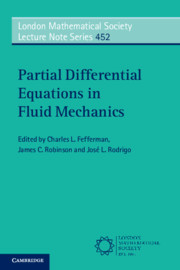Book contents
- Frontmatter
- Contents
- Contributors
- Preface
- 1 Remarks on recent advances concerning boundary effects and the vanishing viscosity limit of the Navier–Stokes equations
- 2 Time-periodic flow of a viscous liquid past a body
- 3 The Rayleigh–Taylor instability in buoyancy-driven variable density turbulence
- 4 On localization and quantitative uniqueness for elliptic partial differential equations
- 5 Quasi-invariance for the Navier–Stokes equations
- 6 Leray’s fundamental work on the Navier–Stokes equations: a modern review of “Sur le mouvement d’un liquide visqueux emplissant l’espace”
- 7 Stable mild Navier–Stokes solutions by iteration of linear singular Volterra integral equations
- 8 Energy conservation in the 3D Euler equations on T2 × R+
- 9 Regularity of Navier–Stokes flows with bounds for the velocity gradient along streamlines and an effective pressure
- 10 A direct approach to Gevrey regularity on the half-space
- 11 Weak-Strong Uniqueness in Fluid Dynamics
3 - The Rayleigh–Taylor instability in buoyancy-driven variable density turbulence
Published online by Cambridge University Press: 15 August 2019
- Frontmatter
- Contents
- Contributors
- Preface
- 1 Remarks on recent advances concerning boundary effects and the vanishing viscosity limit of the Navier–Stokes equations
- 2 Time-periodic flow of a viscous liquid past a body
- 3 The Rayleigh–Taylor instability in buoyancy-driven variable density turbulence
- 4 On localization and quantitative uniqueness for elliptic partial differential equations
- 5 Quasi-invariance for the Navier–Stokes equations
- 6 Leray’s fundamental work on the Navier–Stokes equations: a modern review of “Sur le mouvement d’un liquide visqueux emplissant l’espace”
- 7 Stable mild Navier–Stokes solutions by iteration of linear singular Volterra integral equations
- 8 Energy conservation in the 3D Euler equations on T2 × R+
- 9 Regularity of Navier–Stokes flows with bounds for the velocity gradient along streamlines and an effective pressure
- 10 A direct approach to Gevrey regularity on the half-space
- 11 Weak-Strong Uniqueness in Fluid Dynamics
Summary
This paper reviews and summarizes two recent pieces of work on the Rayleigh-Taylor instability. The first concerns the 3D Cahn-Hilliard-Navier-Stokes (CHNS) equations and the BKM-type theorem proved by Gibbon, Pal, Gupta, & Pandit (2016). The second and more substantial topic concerns the variable density model, which is a buoyancy-driven turbulent flow considered by Cook & Dimotakis (2001) and Livescu & Ristorcelli (2007, 2008). In this model $\rho^* (x, t)$ is the composition density of a mixture of two incompressible miscible fluids with fluid densities $$\rho^*_2 > \rho^*_1$$ and $$\rho^*_0$$ is a reference normalisation density. Following the work of a previous paper (Rao, Caulfield, & Gibbon, 2017), which used the variable $$\theta = \ln \rho^*/\rho^*_0$$, data from the publicly available Johns Hopkins Turbulence Database suggests that the L2-spatial average of the density gradient $$\nabla \theta$$ can reach extremely large values at intermediate times, even in flows with low Atwood number At = $$(\rho^*_2 - \rho^*_1)/(\rho^*_2 + \rho^*_1) = 0.05$$. This implies that very strong mixing of the density field at small scales can potentially arise in buoyancy-driven turbulence thus raising the possibility that the density gradient $$\nabla \theta$$ might blow up in a finite time.
Keywords
- Type
- Chapter
- Information
- Partial Differential Equations in Fluid Mechanics , pp. 50 - 67Publisher: Cambridge University PressPrint publication year: 2018

